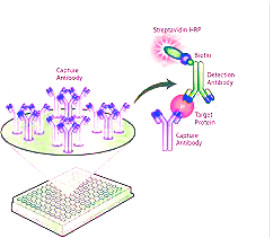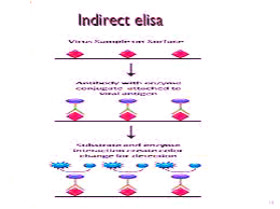Relatively New Methods of ELISA
ELISA, created in 60s-70s in last century, has got a wide good reputation from researchers for its stable reagents, easy operation, objective diagnosis. ELISA biological test is an accurate, sensible, specific testing method. Thus application area of ELISA is expanding rapidly.
Theory
Immunoassay is based on special binding affinities produced by antibodies and antigens, thus any high-quality reagents won’t be produced without good materials such as antibody and enzyme. In the past, the antigens which were applied to immunoassay usually were various purified antigens, and the antibodies of the assay were monoclonal antibody produced by purifying antigen immune animals as well as polyclonal antibody produced by hybridoma technique. Recently, new materials are appearing. For example, some specific antigens or antibodies are made by gene engineering and new immunoassay reagents which are produced by mixture of enzyme. There are various new methods including double-antibody sandwich and indirect assay.
Double-antibody Sandwich Assay
Double-antibody Sandwich Assay, a test for antigen or an application of the ELISA method, is usually used in testing antigens of macromolecules. The double-antibody assay generally include the following four steps:
First step: absorb antiserum containing known antibody at the ori fices of microtiter plate and wash up extra antibody.
fices of microtiter plate and wash up extra antibody.
Second step:add testing antigen. If the two are special,they are bind. Then wash up the extra antibody.
Third step:add adding antibody (secondary antibody) linked to the enzyme with special reaction and make it sandwich.
Fourth step: add substrate of enzyme to check whether the colored enzymatic hydrolysate is produced. If it is, which means that the antigen exist at walls of orifices.
Indirect Assay
The indirect method of ELISA is thus better suited for diagnostic work. There are generally following four steps:
First step, coat known antigen with microtiter plate and wash extra antigen.
Second step, add sample to check whether there is primary antibody w hich is to be tested. If it is, the sample will have specific binding. Then wash up extra sample.
hich is to be tested. If it is, the sample will have specific binding. Then wash up extra sample.
Third step:add secondary antibody linked with enzymes to have specific binding with primary antibody which is to be tested.
Fourth step, wash up extra secondary antibody without specific binding and add enzymes to make enzymes colored. Then test Optical Density in microtiter plate by ELISA reader to estimate the antibody’s content which is to be tested in ultimate product.
